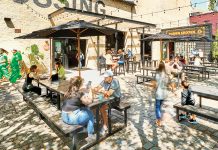Did you know that your very own Minnesota backyard is perfect for traditional applejack making? I had no idea either—until I got to page 121 of Cider, Hard and Sweet the new book on all things cider-related by Ben Watson (Countryman Press, $24.95). Fascinating. All you do is, you just fill a barrel up with hard cider (the beer-like one, not the Calvados-like one) and, well, I’ll let Watson explain it:
“Making applejack involves setting a barrel of hard cider outdoors in the dead of winter. There, in the frigid temperatures (the colder the better), the 75 to 90 percent of the cider that is water begins to freeze. During the day the warmer temperatures allow the alcohol to drain out of the ice, which then refreezes at night, causing greater and greater separation between the increasingly pure water ice and the increasingly concentrated liquor at the ‘heart’ or core of the barrel…Real honest-to-goodness applejack can’t be made in areas where nighttime temperatures in midwinter don’t reliably dip below zero degrees. Really cold temperatures, around -30 degrees, will produce a very strong applejack of 65 proof, whereas relatively warm winter lows, around 5F, will yield a liquor that measures only 20 proof, or 10 percent alcohol. In other words, a difference in climate can mean the difference between an applejack that approaches brandy…and one that merely achieves the potency of apple wine.”
That’s right: The difference between living in International Falls, Minnesota and St. Louis, Missouri is the difference between getting good and drunk or merely tipsy!
I was about to run out and spend a thousand dollars on hard cider in order to get a liter of applejack when I got to page 123, where I learned applejack made this way makes a liquor “affectionately known” as “essence of lockjaw.” (What do they call it when one is not being affectionate?) Evidently, this essence of lockjaw gave its users “epic hangovers” and, for big ice-made applejack drinkers, something called “apple palsy,” because making liquor in your backyard in a barrel creates booze full of impurities like methanol and fusel oil.
So much for the backyard applejack bar I had planned.
Still, if you want to make cider, and perry, I know of no better book than this one. It’s mostly about how to make beer-like hard cider, a worthy pursuit. I’ve been waiting for a local artisinal bottled or kegged cider in Minnesota all my life, and now that I’ve seen a book on how it might be done, I’m more impatient than ever. So, go, read, and get brewing!
Cider, Hard and Sweet
By Ben Watson
Countryman Press, $24.95
www.countrymanpress.com






